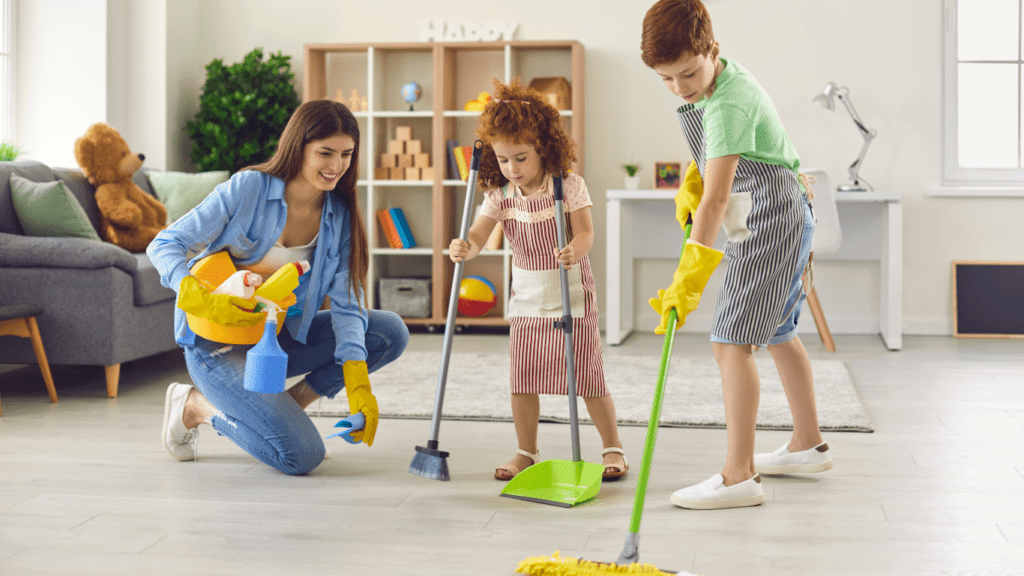Decluttering with kids around can feel like an impossible task. Toys, clothes, and school supplies seem to multiply overnight, turning your home into a chaotic mess. But don’t worry—I’ve got some tried-and-true space-saving hacks that every mom should know.
Understanding the Challenge of Decluttering with Kids
Managing clutter with kids can feel like a never-ending battle. Toys, clothes, and school supplies pile up quickly, making it hard to maintain order. Kids’ constant growth means they’re always outgrowing something, whether it’s clothes, toys, or hobbies. This continuous cycle of outgrowing and replacing adds to the clutter.
Kids often resist letting go of items, attaching sentimental value to everything from old toys to school projects. Their unwillingness to part with things can be a significant hurdle in the decluttering process. Additionally, involving kids in decluttering efforts requires patience, as they may not yet grasp the concept of space management.
Limited storage space compounds the challenge, making it necessary to find creative storage solutions. Balancing the need for functional, child-friendly spaces while maintaining an organized home can be daunting. Understanding these challenges helps in developing effective strategies to manage clutter while creating a harmonious living environment for everyone.
Importance of Decluttering in a Family Home
Decluttering a family home creates a harmonious environment that benefits everyone. Reducing clutter impacts both children and parents positively.
Benefits for Children
Kids experience less stress in organized spaces. A study by the Journal of Environmental Psychology found that cluttered environments increase cortisol levels in children. With fewer distractions, children can focus better on homework and creative activities. Organizational skills develop as they learn to manage their belongings, fostering responsibility and independence. For example, dlikeesignated toy bins and labeled closet sections help kids keep their play areas tidy and find items quickly.
Benefits for Parents
- Parents find it easier to manage daily routines in a decluttered home.
- A survey by the National Association of Productivity & Organizing Professionals indicated that 91% of families feel more productive in clutter-free spaces.
- Reducing clutter reduces cleaning time, allowing parents to spend more quality moments with their kids.
- Stress levels decrease as the home feels more organized and manageable.
- A streamlined kitchen with clear countertops simplifies meal prep and reduces the chaos of morning routines.
Effective Decluttering Strategies
Decluttering with kids may seem daunting, but it can be manageable with the right strategies. Here are key methods to make the process smoother and more effective.
Involving Kids in the Process
Engaging kids in decluttering helps teach responsibility and organization. Start by setting clear goals, such as donating unused toys or organizing clothes. Break tasks into small, manageable steps. For example, sorting toys into “keep,” “donate,” and “trash” piles. Allow kids to make choices within set boundaries, which empowers them and reduces resistance. Praise their efforts to boost motivation and turn the process into a bonding activity.
Creating a Decluttering Schedule
A consistent decluttering schedule maintains order over time. Set aside specific times each week or month for decluttering, making it a regular family activity. For instance, dedicate Saturday mornings to tackle different areas of the home. Use a calendar to visually track progress and establish routines. Prioritize high-traffic zones like living rooms or children’s bedrooms. Rotate focus areas to avoid overwhelm. This systematic approach ensures that clutter doesn’t build up again and keeps the home consistently organized.
Space-Saving Hacks for Different Areas in the Home

Keeping a clutter-free home with kids can be challenging. Efficient decluttering involves smart hacks tailored to each room.
Kids’ Bedrooms
Use under-bed storage containers for seasonal clothes, toys, or extra bedding. Install shelves above dressers to store books and small toys. Utilize wall hooks for bags and hats. Opt for stackable bins to sort different items like art supplies or building blocks.
Living Room and Play Areas
Designate a corner for kids’ toys with attractive storage cubes or baskets. Use multi-functional furniture like ottomans with hidden storage or coffee tables with shelves. Employ wall-mounted storage solutions for board games and puzzles. Rotate toys regularly to avoid overwhelming clutter.
Kitchen and Dining Spaces
Implement drawer organizers for utensils and small items. Use cabinet door racks to hold lids and cutting boards. Opt for stackable containers to maximize pantry space. Hang pots and pans on wall racks to free up cabinet space. Allocate a specific drawer or shelf for kids’ dishes to streamline meal prep.
Teaching Kids to Maintain a Clutter-Free Space
Encouraging kids to maintain a clutter-free space is crucial for long-term organization. Here, I’ll outline effective techniques to help instill such habits in children.
Establishing Routine Habits
Incorporating daily and weekly routines can significantly help kids keep their space decluttered. Morning and evening rituals, such as tidying up toys before bed, reinforce consistency. Weekly clean-ups allow kids to reset their areas regularly.
- Daily Rituals: Allocate 10 minutes each evening for a quick tidy-up. Focus on returning toys, books, and clothes to their designated spots.
- Weekly Clean-Ups: Schedule a 30-minute clean-up session every weekend. Engage kids in organizing their desks, shelves, and drawers.
- Visual Reminders: Utilize charts and checklists to track daily and weekly tasks. Visual aids can serve as constant reminders of their responsibilities.
Reward Systems and Positive Reinforcement
Rewards and positive reinforcement can motivate kids to maintain their clutter-free spaces. These methods create a sense of accomplishment and encourage continued effort.
- Sticker Charts: Use sticker charts to mark successful days of tidying up. Accumulating stickers can lead to small rewards, like extra playtime or a special treat.
- Praise and Encouragement: Offer verbal praise and encouragement when kids complete their tasks. Highlighting their efforts boosts their confidence.
- Incentive Systems: Implement a point-based system where kids earn points for each task. Points can be redeemed for rewards such as a family outing or a new book.
Maintaining a clutter-free space is achievable by teaching kids through routines and positive reinforcement. Implementing these strategies fosters a responsibility and organization mindset.




